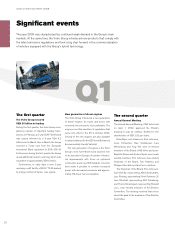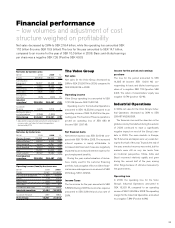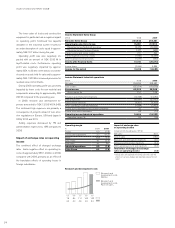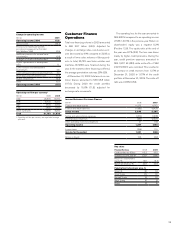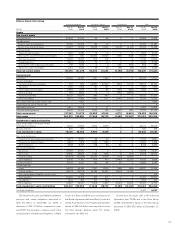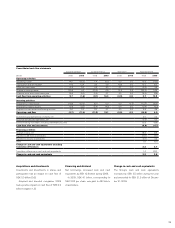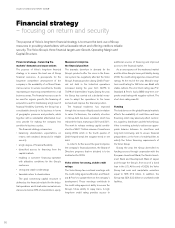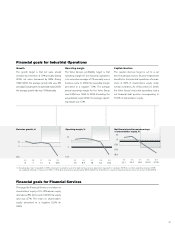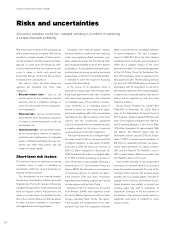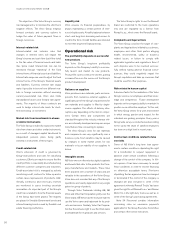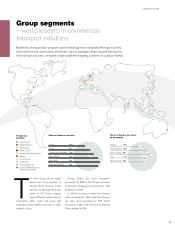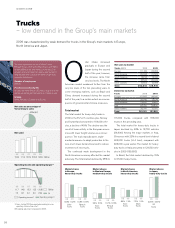Volvo 2009 Annual Report Download - page 34
Download and view the complete annual report
Please find page 34 of the 2009 Volvo annual report below. You can navigate through the pages in the report by either clicking on the pages listed below, or by using the keyword search tool below to find specific information within the annual report.
BOARD OF DIRECTORS’ REPORT 2009
Financial strategy – balancing the
markets’ demands and expectations
The purpose of Volvo’s long-term nancial
strategy is to ensure the best use of Group
nancial resources. A prerequisite for the
long-term competitive development of the
company is the availability of sufcient nan-
cial resources to secure investments, thereby
maintaining or improving competitiveness in all
business areas. The nancial resources are to
be used for organic growth, the nancing of
acquisitions and for maintaining a high level of
nancial exibility. Currently, the Group has a
considerable diversity in its business in terms
of geographic presence and products, which
together with a substantial aftermarket busi-
ness provide for making the company less
sensitive to business cycles.
The nancial strategy is based on:
balancing shareholders expectations on •
returns with creditors’ demands for reliable
security
a high degree of nancial exibility •
diversied access to nancing from the •
capital markets
enabling a customer nancing operation •
with attractive conditions for the Group’s
customers
strong and stable credit ratings •
favorable return to shareholders.•
The goal concerning capital structure is
dened as the nancial net debt for the Indus-
trial operations and it shall under normal circum-
stances be below 40% of shareholders’ equity.
Measures to improve
the financial position
The dramatic downturn in demand for the
Group’s products after the crisis in the nan-
cial system has negatively affected the Volvo
Group’s nancial position during 2009. Finan-
cial net debt in the Industrial operations
increased during the year from 39,7% to
70,9% of shareholders’ equity. During the year,
the Group has carried out substantial meas-
ures to adapt the operations to the lower
demand and improve the nancial position.
The nancial readiness has improved
through the increase of liquid assets in relation
to sales. Furthermore, the maturity structure
on Group debt has been extended, which has
reduced the loans maturing in 2010 and 2011.
The work to release working capital contrib-
uted to a SEK 17 billion release of inventories
during 2009, which in the fourth quarter of
2009 helped break the negative trend in net
debt.
In order to further assist the goal to improve
the company’s nancial position, the Board of
Directors proposes that no dividend is to be
distributed for 2009.
Volvo strives for strong, stable credit
ratings
The Volvo Group has continual meetings with
the credit rating agencies Moody’s and Stand-
ard & Poor’s to update them on the company’s
development. These meetings contribute to
the credit rating agencies’ ability to assess the
Group’s future ability to repay loans. A high
long-term credit rating provides access to
additional sources of nancing and improved
access to the nancial market.
As a consequence of the weakened market
and the Volvo Group’s lower protability during
2009, the credit rating agencies lowered their
ratings. At the end of the year, Moody’s long-
term credit rating for AB Volvo was Baa2 with
stable outlook. The short-term rating was P-2.
Standard & Poor’s had a BBB long-term cor-
porate credit rating with negative outlook. The
short-term rating was A3.
Funding
The turbulence on the global nancial markets
affects the availability of credit lines and loan
nancing, which may adversely affect custom-
ers, suppliers, distributors and the Volvo Group.
Volvo is working actively to achieve an appro-
priate balance between its short-term and
long-term borrowing, and to ensure nancial
preparedness in the form of credit facilities to
satisfy the future nancing requirements of
the Volvo Group.
During the year, the Group diversied its
funding sources through cooperation with the
European Investment Bank, the Nordic Invest-
ment Bank and Development Bank of Japan
and through the Group’s rst issue of a bond
loan in the U.S. At the end of 2009, the Volvo
Group had cash and marketable securities
equal to SEK 37.9 billion. In addition, the
Group had SEK 33.3 billion in unutilized credit
facilities.
Financial strategy
– focusing on return and security
The purpose of Volvo’s long-term nancial strategy is to ensure the best use of Group
resources in providing shareholders with a favorable return and offering creditors reliable
security. The Volvo Group’s three nancial targets are: Growth, Operating Margin and
Capital Structure.
30


